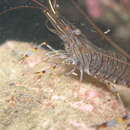Biology
(
Inglês
)
fornecido por Arkive
The common prawn is omnivorous. The sexes are separate, and breeding occurs between November and June. Fertilisation is external, and occurs as the eggs leave the female's body. The female then carries the eggs around attached to hairs on her pleopods, up to 4000 eggs are carried for around 4 months. The planktonic larvae settle in July or August and begin to breed in February of the next year (2).
Conservation
(
Inglês
)
fornecido por Arkive
Conservation action is not needed for this species.
Description
(
Inglês
)
fornecido por Arkive
The common prawn is a well-known swimming crustacean, which is pinkish-brown in colour and features reddish spots and lines (2). The head and thorax are protected by a relatively thin carapace which, as in many species of prawns and shrimps, is drawn out into a projection between the eyes known as a 'rostrum' (2). The distinctive rostrum can be used to distinguish the common prawn from other species. In this species, the rostrum curves upwards, is divided in two at the tip with 6 or 7 teeth along its upper surface and 4 or 5 teeth on the underside (3). The first five segments of the abdomen bear fringed appendages known as pleopods or 'swimmerets' that are used to propel this prawn through the water. The first three appendages on the thorax are modified for use in feeding, and the remaining five pairs are known as the 'pereopods'. In this species, the first and second pairs of pereopods are tipped with pincers (2). This prawn may become infected with an isopod parasite which causes large swellings, a condition known as 'face-ache' (2).
Habitat
(
Inglês
)
fornecido por Arkive
This species occurs offshore to depths of around 40 m (2). It may also be found on the lower levels of the shore in rock-pools amongst seaweeds (2). It may also occur in the lower parts of estuaries (3).
Range
(
Inglês
)
fornecido por Arkive
Found mainly around the south south-west and western coasts of Britain. Elsewhere it is found from Denmark to Mauritania, and is found in the Mediterranean and Black Seas (3).
Status
(
Inglês
)
fornecido por Arkive
Not threatened (2).
Threats
(
Inglês
)
fornecido por Arkive
This species is not threatened.

